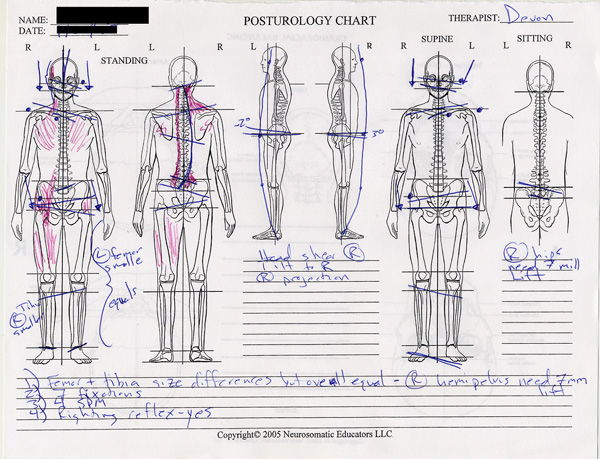Posturology
Posturology is the study of posture. My training is through Neurosomatic Educators based out of Tampa Florida. It is Paul St John's approach to charting the body, such that the structural imbalances become apparent. It also provides a standard to measure therapeutic progress.
Below is an example of the charting I do. Measurements are taken standing, lying down, and sitting. Generally, the body should be treated based on imbalances that are present during standing. Because the body is always trying to keep the eyes level with the horizon; it bends, twists, and rotates in whatever way it needs to right the eyes. If our eyes are not level, we experience vertigo and cannot do anything. In nature, we would become prey if our eyes did not function correctly. So, keeping the eyes level, the righting reflex is a top-level priority for the body; and gravity has everything to do with how that works. When lying down, most if not all imbalances should correct. When they do not correct, we call them a fixation. Bodywork and massage are particularly good at correcting fixations. If the body goes into dysfunction in a new way when lying down, we call that a subtle proprioceptive mechanism. It indicates that the person needs visceral work; one of their organs is under unusual stress. I can also get a pretty good idea of whether there is a leg length imbalance from the lying down measurements. Taking measurements while a person is sitting allows me to determine if their hips are equal in size.
In the example below, the person's hips have gone into an oblique position, the right ilium is flaring in and the left is flaring out. Typically when this happens the temporal bones in the head go into an oblique position in the opposite way. As goes the hips, so goes the head, in an opposite way. When obliqueness is present and unaddressed, no other bodywork will stick and provide lasting results. Obliqueness locks in place most imbalances.
The person below has a smaller right tibia and fibula, lower leg, and a smaller left femur, upper leg. Between the imbalances in both legs, they are equal. At first it appears noteworthy but it turns out not to be causing any problems.
From the sitting position, I determined that the right ilium is smaller than the left. First, I take all the measurements. Then if the hips are out of place and I suspect a leg or hip length/height difference, I will put the hips into a balanced position and then see how much lift is required under one of the feet and/or hips to put the body into structural balance. In this case, the person needs a 7 mm lift under the right foot when standing and a 7 mm lift under the right sit bone when sitting to prevent the imbalances I've charted from occurring.

I see that the left foot has a fallen arch. This is part of the body's compensation for trying to cope with one side being bigger than the other. Likewise, the left hip rotates into a negative position allowing the head of that femur to be higher, making the leg functionally a little shorter. The right side of the body in this example is projecting, tilting forward. With all of the compensations that the body is doing, it has actually made this person's body functionally smaller on the left side and as a result, the right is rotating and tilting forward. Generally when in balance otherwise, the body will rotate and tilt forward on the bigger/longer side.
When the body is structurally in balance, the left and right sides are even and level when the person is standing up in the three planes, sagittal, coronal, and transverse, correct posture comes natural. It does not require effort or special awareness. When a person has bad posture, it usually is not their fault. It isn't because they are lazy. They, in fact, have to work very hard to deal with all of their imbalances. The body has more energy and is more efficient when it is in structural balance. Further, form affects function. The organs and glands, and in fact all physiological aspects of the body, work better when there is structural balance. For example, when one side of the body is more out of balance than another, it is not uncommon for the associated armpit to produce less favorable scent. Quality of scent is, in general, directly related to structural balance. From the point of view of nature, it makes complete sense. Survival of the fittest and mating is driven by scent. Another example of form affecting function is that when a person has a smaller hip on one side and obliqueness increasing towards its maximum, a person can experience dyslexia. The bones in the head should move oppositely from the hips. When the bones in the head get out of balance enough, parts of the brain do not communicate with exact precision. Memory has very specific positioning. When the bones in the head go out of balance, the brain's ability to calculate correct positions for certain types of memory is affected.